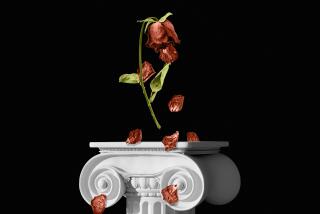Riding Out a Bridal Wave
- Share via
The scenes in Chris O’Donnell’s upcoming film, “The Bachelor,” are bound to be memorable: a thousand brides chasing one reluctant bachelor around the streets of San Francisco and Los Angeles. And moviegoers will probably wonder how on earth the movie’s crew found, fit and disposed of the 1,000 bridal gowns that were worn by extras in key scenes of the romantic comedy.
The movie, a remake of the Buster Keaton classic “Seven Chances,” opens Nov. 5 and co-stars Renee Zellweger and Brooke Shields in a story about a guy who has 24 hours to find the right woman to marry or else lose a $100-million inheritance.
Finding 1,000 wedding gowns was a logistical nightmare, said the show’s costume designer, Terry Dresbach. Digitally reproduced brides wouldn’t fulfill director Gary Sinyor’s need for close-ups, said Dresbach, who had only two weeks--and not much money--to find the gowns.
After a virtual phone-a-thon and hours of research, Dresbach turned to the Internet to find resale bridal stores. She found Phyllis Kelley’s Brides to Be, a consignment store in Glastonbury, Conn.
“This woman had a resale shop and apparently had a bad buying habit, because she had 800 dresses stacked in her bedroom. They were new, but out of date,” Dresbach said. “They had every kind of bell and whistle and hoo-ha on them.”
At $75 a gown, Kelley emptied her bedroom and, in another miracle, volunteered to drive the gowns across country, thereby minimizing shipping charges. The catch? She wanted her daughter to be one of the brides. No problem.
The effort to make 1,000 wedding gowns fit 1,000 extras was “like running some kind of military campaign,” Dresbach said. The gowns were arranged in a San Francisco airplane hangar, where 35 wardrobe assistants worked for three days making minor alterations. Too-long hems or trains on the gowns, some of which cost $3,000 new, were sliced off at the rate of 200 gowns an hour. The remnants were stuffed into trash bags.
Nothing was wasted, though. When an open casting call netted more brides than there were gowns, some women took bags of the discarded trains as a consolation prize. Several returned the next day with gowns pieced from remnants and won spots in the gown-clad crowd.
Like a mobile version of those mass weddings, every morning at 4 a.m., brides loaded on to dozens of buses, got dressed and rode to locations.
After filming, Dresbach was pressed to find a new home for the gowns. Costume shops don’t want to store them, she said. And they weren’t good resale candidates, but they were still in good enough shape for someone to wear again, though maybe not for a walk down the aisle.
“There aren’t a lot of movies that call for 1,000 wedding dresses. What do you do with them?” she said.
The movie’s publicists at New Line Cinema, which now owns about 750 of the gowns, came up with a partial solution. From now until the film’s release, dozens of “brides” across the country will be walking down the aisles of sporting events, concert halls, shopping malls and even busy intersections carrying placards and banners promoting the movie.
They’ll take blocks of seats at Dallas hockey games, Chicago football games and Minneapolis wrestling matches. They’ll parade through campuses such as UCLA and USC and stand in line at the movie’s Hollywood premiere.
Some will have an afterlife at the L.A. schools and church groups that received gowns as donations from Dresbach. Others will be worn by trick-or-treaters. “Every kid I know has a bag of bridal trains in their closet,” she said. “My 4-year-old neighbor this year is going to be a white, glittery fairy princess for Halloween.”
New Line still has gowns in warehouses that may be used in promotions for the foreign and home video releases. So maybe they were never used for their intended purpose, but they may get a chance to live happily ever after anyway.
Valli Herman-Cohen can be reached by e-mail at valli.herman-cohen @latimes.com.
More to Read
Only good movies
Get the Indie Focus newsletter, Mark Olsen's weekly guide to the world of cinema.
You may occasionally receive promotional content from the Los Angeles Times.










